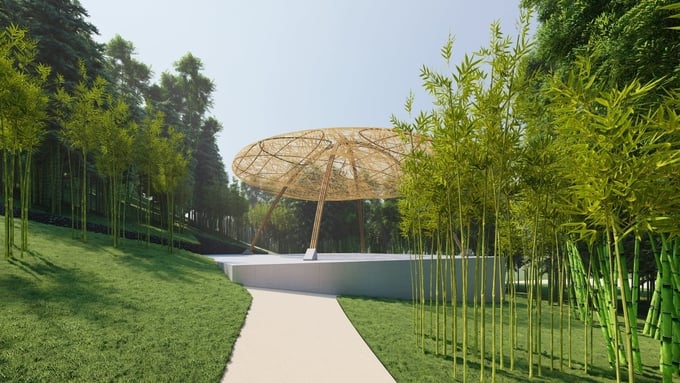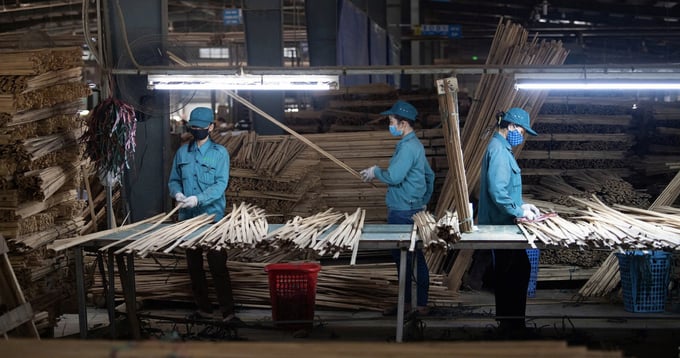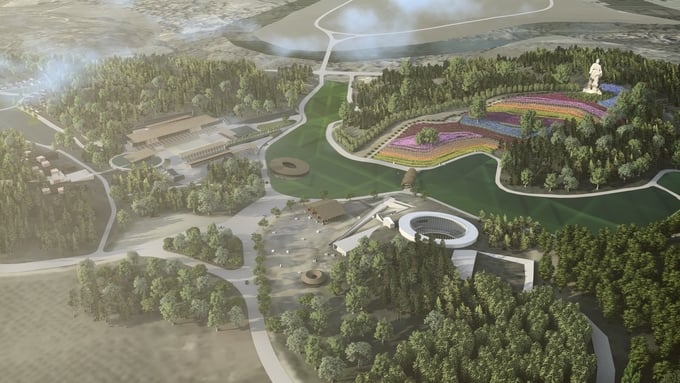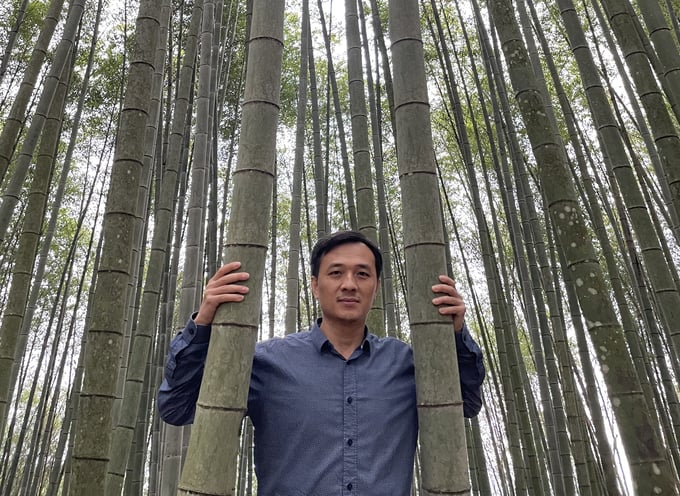December 3, 2025 | 20:22 GMT +7
December 3, 2025 | 20:22 GMT +7
Hotline: 0913.378.918
December 3, 2025 | 20:22 GMT +7
Hotline: 0913.378.918
Within the World Bamboo Organization network, the Vietnamese people's strong sense of community, solidarity, and harmony is often recognized as a cultural symbol, much like bamboo itself.
In the past, Vietnamese life revolved around agriculture, and bamboo played an essential role in daily living. Household items such as tables, chairs, baskets, and even farming tools like water scoops and shoulder poles were primarily made from bamboo. Though not an everlasting material, bamboo is lightweight, durable, and highly flexible. Nearly every home had a bamboo grove in its garden, ready to be harvested whenever needed.

Bamboo serves as both a material and a source of cultural richness in Vietnamese daily life. Photo: Architect Nguyen Manh Tuan.
Generations of Vietnamese artisans refined the craft of working with bamboo, turning it into everyday essentials. This knowledge, passed down through time, forms a precious cultural heritage. Bamboo was not just a material, it enriched daily life in the most natural and unpretentious way.
In her 1997 memoir Earth and Water, writer Edith Shillue praised the bamboo shoulder pole as one of the most romantic symbols of the East. Flexible and resilient, it moves in harmony with every step of the worker. From peaceful countryside villages to bustling city streets, the bamboo shoulder pole has remained a constant presence, adapting to urban life while preserving its simplicity and authenticity.
In the past, entire markets were dedicated solely to bamboo products, offering practical solutions to many economic challenges. It can be said that bamboo's life cycle is deeply intertwined with the natural rhythms of both Vietnamese agriculture and daily life.
However, as a natural consequence of socio-economic development, rapid urbanization has led to a decline in the demand for bamboo in construction and interior design. Traditional bamboo-related crafts are gradually fading, forcing many skilled artisans to abandon their trade and seek alternative livelihoods.
Today, fewer people possess the intricate bamboo processing skills passed down through generations, such as splitting, weaving, and crafting beds, cabinets, and other household items. As a result, the cultural significance of bamboo is slowly diminishing. While bamboo products are still available for purchase from craft villages, the hands-on knowledge and craftsmanship are no longer widely preserved.

Bamboo is a versatile and environmentally friendly material with vast potential in architecture and infrastructure. Photo: Trung Quan.
Without engaging in the production process or understanding the origins of these products, people are losing their connection to bamboo and the cultural heritage it represents.
I believe that if we reintroduce small bamboo crafts into our homes, the spiritual and cultural value of bamboo will be rekindled, strengthening our bond with this deeply rooted tradition.
As the world's fourth-largest bamboo producer – following China, India, and Myanmar – Vietnam must establish a sustainable strategy for bamboo cultivation and utilization. Notably, most of the country’s bamboo grows naturally, without structured planning or proper management.
In the field of architecture, bamboo stands out as a highly adaptable and eco-friendly material with vast potential for urban development. It would be a tremendous waste to leave this resource underutilized.
Since 2019, I have had the privilege of continuing the dream of Labor Hero Le Van Tam, who played a key role in developing Thanh Hoa’s sugarcane-growing region. While he is widely recognized as a pioneering agricultural official in the late 1980s and early 1990s, few people know of his deep passion for bamboo, especially the indigenous Lam Son bamboo variety.
While serving as Chairman of the Board of Directors at Lam Son Sugarcane Joint Stock Company, Le Van Tam invested in the Thanh Tam Bamboo Ecological Park project. Spanning 160 hectares, the park dedicates 60 hectares to natural bamboo forests. It also features four Friendship Bamboo Gardens, showcasing hundreds of bamboo species from around the world. Once completed, this project promises to become a unique center for bamboo conservation and exhibition.

3D design of the cultural space of Thanh Tam Bamboo Ecological Park. Photo: Architect Nguyen Manh Tuan.
In another community-driven initiative, I collaborated with artisans from Xuan Lai Village to design and construct a bamboo exhibition within Ho Van, the cultural space of the Temple of Literature - Quoc Tu Giam. While bamboo has yet to be recognized as an official building material under Vietnam’s Construction Law, this lack of formal classification has allowed architects the creative freedom to integrate bamboo into historical and cultural spaces in innovative ways.
Bamboo plays a role in agriculture, industry, and cultural heritage. As management systems become more open and interdisciplinary, the use of bamboo is expected to expand. However, if exploited unsustainably, it could lead to deforestation, soil degradation, and long-term environmental damage.
To develop a sustainable bamboo industry, a careful balance must be struck. Cultural values act as a bridge between economic benefits and community well-being. It is crucial to ensure that farmers – the very people who nurture and protect this resource – also reap tangible benefits.
Focusing solely on factory production and mass bamboo harvesting without sustainable management would not only deplete resources but also erode traditional cultural values. If bamboo is reduced to a mere industrial crop, its deeper significance in daily life will fade. In contrast, artisans who master the craft of weaving and shaping bamboo experience a unique blend of economic reward and spiritual fulfillment – something far beyond what is gained through simple cultivation and exploitation.

For World Bamboo Ambassador - Architect Nguyen Manh Tuan, bamboo is always in harmony with nature, penetrating every moment of life.
Proper planning is essential for sustainable bamboo cultivation, ensuring that exploitation does not disrupt the ecological balance. Bamboo should be integrated into the ecosystem rather than grown as a dominant species. This principle aligns with bamboo’s role throughout history. Much like scaffolding, it serves as a temporary support for structures, always ready to make way for more permanent materials when needed.
On a global scale, the World Bamboo Organization has expanded its activities across multiple fields, including policy, industry, architecture, urban planning, food production, forestry, and recycling. One notable initiative led by the organization's president is the development of a bamboo aircraft hull, designed to reduce fuel consumption and enhance sustainability.
In Vietnam, bamboo holds great potential for rapid response projects. Its lightweight, transportable, and easily processed nature makes it an ideal material for post-disaster housing construction. Beyond providing immediate relief, bamboo-based solutions can contribute to long-term sustainable development, aligning with Vietnam’s natural environment and socio-economic conditions.
Translated by Quynh Chi
/2025/12/01/0509-2-175427_206.jpg)
(VAN) Emission-reducing coffee areas in Lam Dong have entered the new crop with stable yields, improved quality, and a remarkably enhanced cultivation environment.

(VAN) The Institute of Agricultural Sciences for Southern Vietnam (IAS) marked its 100th anniversary in Ho Chi Minh City, celebrating a century of growth as a leading institute contributing significantly to Viet Nam’s agricultural development.

(VAN) An increasing number of livestock farms are using biogas generators to create a source of renewable electricity, helping to save costs and mitigate environmental pollution.

(VAN) Small changes in rice cultivation, from irrigation methods and straw collection to input management, are paving a new way for Vietnam's agriculture in the journey toward emission reduction.

(VAN) With the project of converting biogas into renewable electricity, Australia is both helping pig farms reduce their energy costs by up to 25% and contributing to environmental protection.
![Hue aims for Net Zero: [1] Initial steps from green transportation](https://t.ex-cdn.com/nongnghiepmoitruong.vn/608w/files/huytd/2025/11/28/0853-anh-6-giao-thong-xanh-hue-094717_940-153724.jpg)
(VAN) For sustainable development, Hue City is implementing many solutions to promote green transportation, which is an important initial step on the journey to building a Net Zero Hue.

(VAN) Nghe An Province, one of the localities with the largest forest area in Vietnam, is set to gain significant benefits from the implementation of forest carbon credit payments.